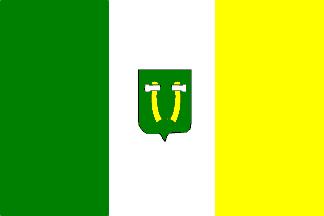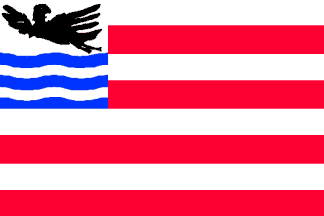
Last modified: 2018-12-15 by rob raeside
Keywords: midden drenthe |
Links: FOTW homepage |
search |
disclaimer and copyright |
write us |
mirrors
![[Midden Drenthe flag]](../images/n/nl-dr-md.gif) Shipmate Flagchart : http://www.flagchart.net
Shipmate Flagchart : http://www.flagchart.net
At the Midden Drenthe website
is the following description of the flag of Midden-Drenthe.
The municipal flag is green with four yellow fleur-de-lis placed crosswise.
The four centrally directed lilies refer to the central position in Drenthe
and to the name of the municipality (midden=center).
They have been derived from the provincial
Coat of Arms, in which the Virgin Mary is depicted with a lily-staff and lily-crown.
The green color refers to the environment and agriculture.
The flag is only used for official municipal occasions.
Flag adopted: 29 Jun 2002.
Jarig Bakker, 3 May 2003
![[Midden Drenthe Coat of Arms]](../images/n/nl-dr)md.jpg) image from the Midden Drenthe website
image from the Midden Drenthe website
The coat of arms was granted by Royal Resolution on 6 May 2002 to the
municipality of Midden-Drenthe. It is being used on official occasions.
Description: "Vert. four fleur-de-lys or crosswise; in the canton an eagle
regardant rising armed or, statant with the left leg on the central mound
of a three-mounded peatmountain naturel. The shield surmonté with
a crown or with three leaves and two pearls, and supported by two horses
noir".
In the new Coat of Arms elements from the arms of all three former municipalities
have been used. The color green from the Beilen Coat of Arms, to the green environment
and agriculture. The (original) Lordship-arms of Hoogersmilde refers to
Smilde and the peat-digging. The horses as supporters are from the arms
of Westerbork, with its agriculture and recreation.
Source: Midden Drenthe website
Jarig Bakker, 3 May 2003
 image by Jarig Bakker, 7 Dec 2003
image by Jarig Bakker, 7 Dec 2003
Flagdescription: Three equally wide vertical stripes of green, white
and yellow, the white stripe with the municipal shield.
This flag was adopted 22 Aug 1938 by municipal resolution. The colors
of the stripe are derived from the Coat of Arms.
Source: Sierksma's Nederlands Vlaggenboek, 1962 [sie62].
Jarig Bakker, 7 Dec 2003
 Shipmate Flagchart : http://www.flagchart.net
Shipmate Flagchart : http://www.flagchart.net
Flag: rectangular, eight equally wide horizontal stripes of white and
red with in the canton a square of 1/2 flagheight, with the canton of the
municipal arms, the black eagle and five wavy stripes blue - white - blue
- white - blue.
Adopted by municipal resolution - date unknown.
Smilde is now part of the municipality of Middenveld in Drenthe, the
Netherlands.
The flag is derived from the municipal Coat of Arms.
Jarig Bakker, 8 August 1999.
 Shipmate Flagchart : http://www.flagchart.net/flags.htm
Shipmate Flagchart : http://www.flagchart.net/flags.htm
Flag: four blocks of yellow and red partitioned per Scandinavian cross;
over the two blocks at the hoist a standing falcon in resting pose countercharged.
Adopted 6 May 1966 by municipal resolution.
Westerbork is since 1 Jan 1998 part of the municipality of Middenveld
(Drenthe, the Netherlands).
Its flag is partly derived from the Coat of Arms. The bird is a falcon; in olden
days the church of Westerbork had to pay 'valkengeld' (falcon-money)
to the city of Steenwijk.
Jarig Bakker, 8 August 1999.
![[Witteveen village flag]](../images/n/nl-dr_wv.gif) image by Stefan Lambregts, 28 Feb 2010 http://www.flagchart.net
image by Stefan Lambregts, 28 Feb 2010 http://www.flagchart.net
Stefan Lambrechts spotted at this
webpage a village flag for Witteveen, municipality Midden-Drenthe, Drenthe
province.
On 21-23 July 2006 there were celebrations for the 80th birthday of
the village, and a village flag was adopted, designed by Michiel Prijs.
Witteveen as a non-village straddled on the border of the former municipalities
of Westerbork and Zweelo.
It was settled by the people who first started digging the peat and who
had to be without vice, as anyone developing lewd behavior was sent away.
So far the village hasn't been dignified a nickname.
The name "Witteveen" (white bog) refers probably to white cotton-grass
('wit wollegras', Latin Eriophorum vaginatum, of the family of Cyperaceae.
The village counts c. 600 inhabitants. It has since 1939 a meteorological
station of the KNMI (that's the Dutch institute which procuces rotten weather
and then predicts it).
Flagdescription: five horizontal stripes green, white, brown, white,
green, proportioned 2:1:2:1:2; on brown in white "Witteveen 1926"; a green
hoisttriangle, separated by a white chevron from the other colors; in center
of white a black goat.
Symbology (probably): green for the surrounding forests; white canting
for the village's name; brown for the bogs and peat; when the village was
settled every laborer got a house (huusje) with a 'ton' (barrel,
wc) and two small sheds: for a goat and a pig - the goat on the flag refers
to that pioneer's age; she also parades proudly on the logo of the local
soccerclub.
Jarig Bakker, 2 Mar 2010